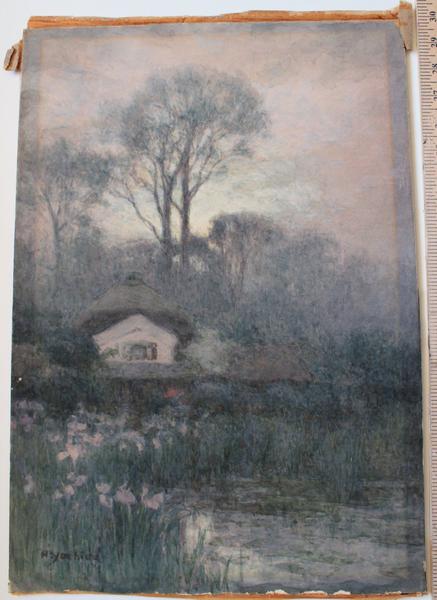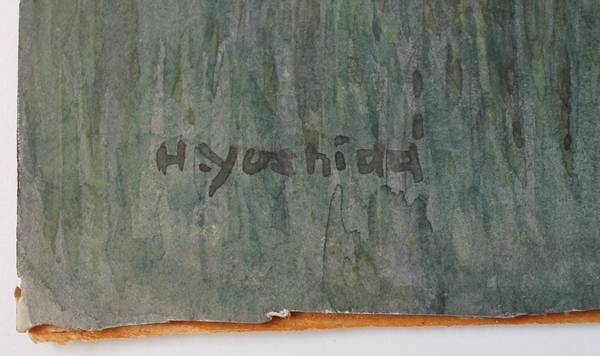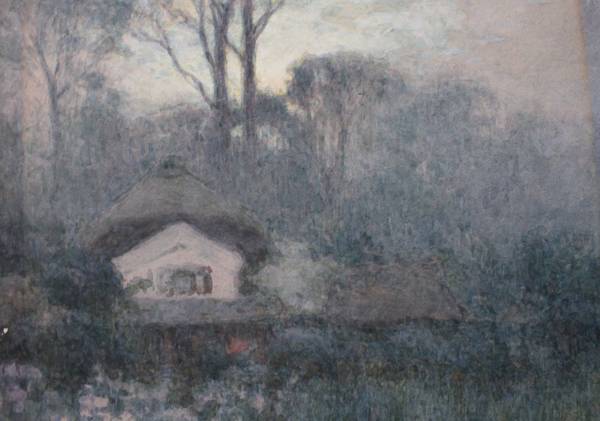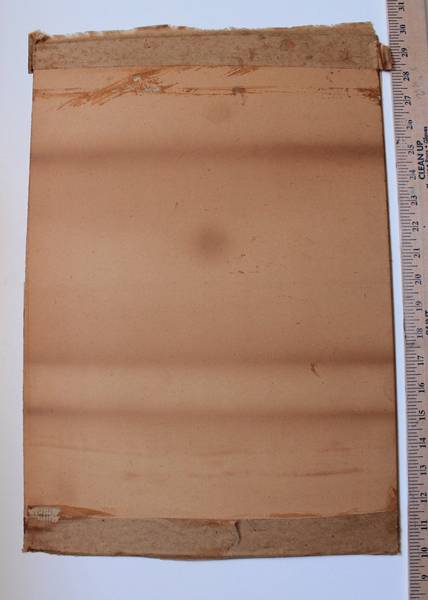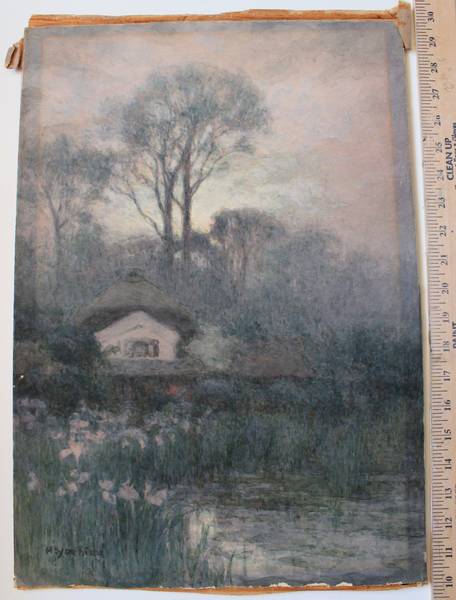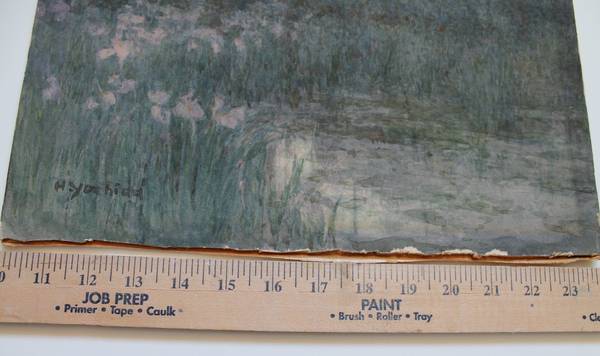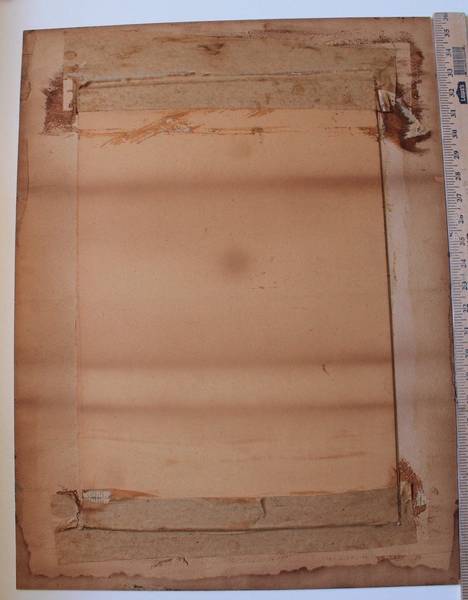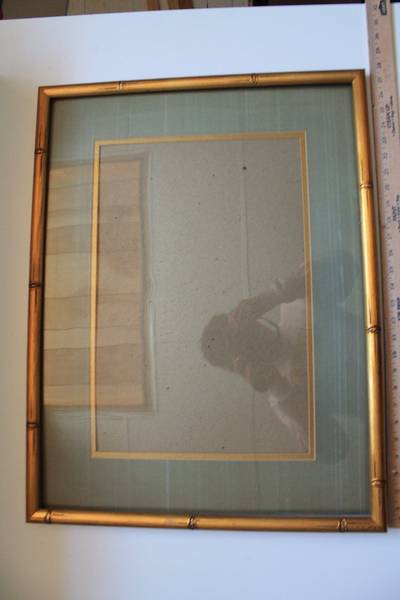| | |
| Artist: | Yoshida Hiroshi (1876-1950) — 吉田博 |
| Title: | Farmhouse by Pond and Iris (given title; official title unknown) |
| Series: | |
| Date of first edition?: | circa 1900-1920 |
| Publisher (first edition)?: | Self |
| Publisher (this edition)?: | Self |
| Medium (first edition): | Watercolour |
| Medium (this edition): | Watercolour |
| Format (first edition): | Large Oban
|
| Format (this edition): | Large Oban |
| DB artwork code: | 46478 |
| Notes (first edition)?: |
I am offering an early watercolor (~1900?) by Hiroshi Yoshida. It has faded a bit from exposure to light (the camera makes this seem much more noticeable than the eye...), but is still a magnificent tonalist study in color. The close- valued hues are layered delicately and seem to melt into a glorious "gloaming' light. It is a subtle piece.
I consigned this watercolor awhile back with ?? Auctions and they offered it in their May 17, 2014 Art Auction (Lot # ??) with a rather poor picture and the following description:
"The work of art is in fair condition. Signed "H. Yoshida" lower left recto. The work of art has been laid down to a non-achival board. The paper has been cut, badly, to fit the board. Taped down, in back, to a mat board."
The piece was passed, maybe the $??. Opening was a bit ambitious at that time, but I would object to the assessment that the watercolor is only in "fair" condition and also that the paper had been cut badly, to fit the backing board. The sheet was actually mounted first and then trimmed. It is the original frame job, complete with glass that has a ton of figure and is actually warped to match the slight warping of the frame. I could have easily tidied up the cut on the lower edge (see final photo) but in the interest of preserving this piece I left it as found. Keep in mind that Yoshida's fully developed watercolors were from early in his career and he was not as famous as later on, when his mastery of the woodblock print ensured his enduring fame. Later, after woodblock prints became Yoshida's primary focus, his watercolors were mostly brief studies for his prints in which he worked out composition and palette. Thus, the framer was perhaps not as conscientious as he may have been. In any case, the lower edge is far from the signature and matted image.
The paper and board are 20" x 14", the mat opening is 18 7/8" x 12 1/2" and the OVERALL framed size is 27 1/2" x 21". Aside from the mild fading, the watercolor is good. The backing board, while not archival, is certainly stable.
The frame is a gilded bamboo-style moulding with an outer silk mat in pale green and a gold pebbled inner mat. |
|
| Notes (this edition)?: |
|
| Artist Bio: |
Yoshida Hiroshi (1876-1950)
This article is a review of the book The complete Woodblock Prints of Yoshida Hiroshi published by ABE Corporation, ISBN 4-87242-121-3.
Portrait of Yoshida Hiroshi
Yoshida Hiroshi is considered one of the leading figures of the renewal of Japanese printmaking after the end of the Meiji period (1912). The renewal was based on two groups of artists, the shin hanga (modern prints) and the sosaku hanga (creative prints) movement.
The Son of a School Principal
Yoshida Hiroshi was born as the son of an elementary school principal. His artistic talent was discovered early and at the age of 18 he entered a private art school in Tokyo.
Yoshida started as a painter and soon won many exibition prizes. But it was not before 1920 that he started creating woodblock prints. Yoshida Hiroshi then met Watanabe Shozaburo, publisher and owner of the Watanabe print store in Tokyo. Watanabe published the first seven of Yoshida Hiroshi's woodblock prints.
The Making of a Japanese Print
The Shalimar Gardens, 1932
The traditional process of creating a Japanese woodblock print was a cooperation of three strictly separated skills: the artist who designed the print subject, the carver and finally the printer and publisher. In contrast, the sosaku hanga followers believed that the process of creating a print - design, carving, printing - should be performed by the artist himself.
Although Yoshida is usally considered as a member of the shin hanga movement, he followed the same ambitions of creating a print by himself.
In 1923 Watanabe's store was completely destroyed in the fires that followed the great earthquake. All of Yoshida's woodblocks and more than a hundred of his prints were lost.
After coming back from his third visit to the United States, Yoshida in 1925 started employing his own artisan carvers and printers. He supervised them very closely and often he carved a block himself. He thought that he had to be more skilled in all aspects of producing a print than each of his workers.
Yoshida Hiroshi - an Avid Traveller
Kinoe, 1930
Yoshida travelled a lot. He came to the United States, Europe, Africa, India, China, Korea and througout Japan. Another passion was mountaineering. He even established an association called Nihon Sangakuga Kyokai, the Japan Alpine Artist Association. His prints reflect both his love for travelling and for mountains. Most of his prints show landscape scenes from his travels and mountain subjects from Japan and the European Alps.
Although his roots were in Japanese traditions, Yoshida was a real cosmopolitan artist who merged both worlds to something new and fascinating. When looking at his print scenes from abroad, you have the impression of being "on the spot". Yoshida is cited with the words "True art is cosmopolitan and the result therefore of external influences as well as of the inherent vitality and life of the different nations". Towards the end of his life, he planned a series entitled One Hundred Views of the World. Yoshida died before he could put his dream into reality.
At the end of his life, Yoshida Hiroshi had created 259 woodblock prints - seven published by Watanabe and the rest by Yoshida himself. It should not be forgotten that he gave the world even more than his own works of art: His both sons, Toshi and Hodaka Yoshida became great artists themselves.
The 1985 Commemorative Collection edition (西集記念)
From http://www.shogungallery.com/wwwboard/archive/oldmess/17.html :
In 1985, to celebrate a major exhibition of Hiroshi Yoshida's prints in Japan, Hiroshi's son, Toshi (an artist in his own right) published a number of his father's prints in commemoration, from the original blocks. These prints were of very high quality and according to Toshi limited to 300 impressions.
|
|


